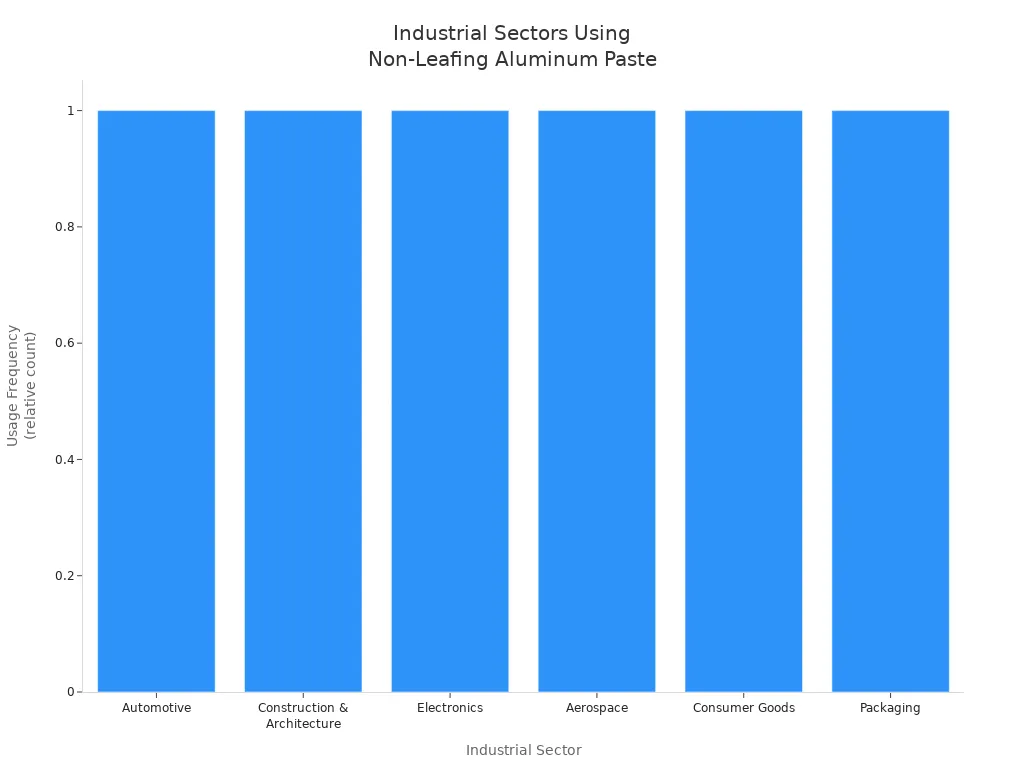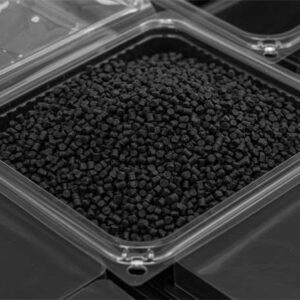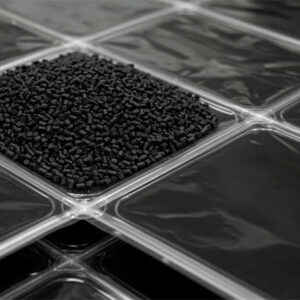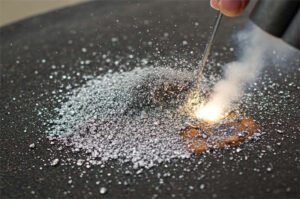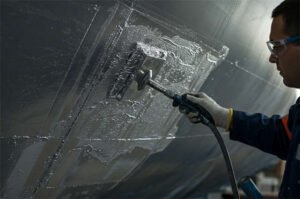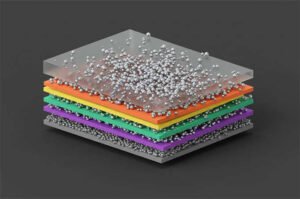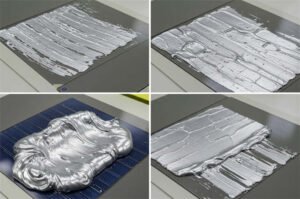Leafing and non-leafing aluminum pastes play different roles in the industrial coating industry aluminum paste market. The way their particles align in coatings affects both the level of light reflection and the degree of protection provided. In the industrial coating industry, aluminum paste is valued for delivering a shiny metallic finish and enhancing the durability of surfaces, which is crucial for applications requiring strength and longevity. Water-based aluminum pastes are becoming increasingly popular in the industrial coating industry aluminum paste sector due to their lower VOC emissions, improved shine, and longer-lasting protection, especially against UV rays. As environmental regulations become stricter, the use of solvent-based aluminum pastes in the industrial coating industry aluminum paste field is declining.
Key Takeaways
- Leafing aluminum pastes make a shiny, mirror-like look. The flakes float and lay flat on the top. This is good for pretty top layers.
- Non-leafing aluminum pastes spread flakes all through the coating. They give strong protection and stick better. The look is softer and more metallic. These are good for tough, long-lasting jobs.
- Water-based aluminum pastes lower harmful fumes. They help the environment. Solvent-based pastes are stronger against weather and chemicals.
- You must pick the right aluminum paste for your needs. Think about the finish you want and how long it should last. Also, think about how you will use it and the weather.
- Fine grades of leafing pastes make a smooth, bright look. Coarse grades of non-leafing pastes give special effects and cover better.
Key Differences
Particle Orientation
| Feature | Leafing Aluminum Paste | Non-Leafing Aluminum Paste |
|---|---|---|
| Particle Orientation | Flakes lie flat, parallel to the surface | Flakes are dispersed or randomly oriented |
Leafing aluminum flakes line up flat on the coating. This makes the surface look shiny like a mirror. Scientists use special microscopes to see that these flakes are almost perfectly lined up, usually between 3° and 10.5°. This perfect lineup is important for coatings that need to be very bright and look like chrome. Non-leafing aluminum flakes do not line up the same way. They spread out in all directions inside the coating. This makes the surface sparkle instead of looking smooth and shiny. Makers use oleic acid to help spread these flakes evenly in the coating.
How the flakes line up changes how the coating works. Leafing aluminum pigments float and make a thick silver layer on top. This layer makes the coating look bright and metallic. Non-leafing pigments mix with the binder and spread everywhere in the paint. This gives the coating a more even look and helps it cover better. The flat lineup of leafing pigments is needed for a bright and strong color. If the flakes do not line up well, the coating can look cloudy or patchy. More solvent in the mix helps the flakes lay flatter.
The shape of the aluminum flakes is important too. Flat, round flakes, called “silver dollars,” reflect more light than rough “cornflake” shapes. When flakes are lined up well, the coating looks brighter and shinier. Tests show that better flake lineup can make the coating reflect 6% more light and be 7 units shinier. These changes also make the coating tougher and more bendable.
Surface vs. Uniform Distribution
- Leafing aluminum paste particles float on top of the wet coating. This makes a smooth layer called “floating aluminum powder.”
- Additives like stearic acid help these particles float during grinding.
- Non-leafing aluminum paste particles get wet and spread through the whole coating. This is called “non-floating aluminum powder.”
- Oleic acid helps spread these particles evenly.
- The top layer from leafing pastes can make it harder to recoat and less tough against wear.
- Non-leafing pastes protect better against wear and rust and make recoating easier because they spread out evenly.
- The main difference: leafing pastes keep aluminum on the surface, but non-leafing pastes spread it everywhere in the film.
Note: Picking leafing or non-leafing aluminum pastes changes how the coating looks and how strong it is. Leafing pastes give a shiny, reflective finish that is good for decoration or top layers. Non-leafing pastes give strong, long-lasting protection and a softer metallic look, so they work well for tough jobs and repairs.
Leafing Aluminum Paste
Properties
Leafing aluminum paste has thin, flat flakes. These flakes are covered with organic materials. The flakes float to the top of coatings. They line up flat on the surface. This makes the coating look shiny and like a mirror. The flakes form a smooth metallic layer on top. This layer makes the coating glossy and bright. Leafing aluminum paste is usually used with solvents. Solvents help the flakes float and spread well.
| Property | Typical Value |
|---|---|
| Solid Content | 70 ± 1% |
| Viscosity | ≤ 100 mPa·s |
| pH | 7 – 9 (neutral to slightly alkaline) |
| Density | 1.2 – 1.4 g/cm³ |
| Active Aluminum | ≥ 92% |
| Alumina Impurities | ≤ 0.5% |
| Sulphate Impurities | ≤ 0.2% |
| Chloride Impurities | ≤ 0.1% |
The flakes have low surface tension and a long, thin shape. This helps them reflect light very well. That is why leafing aluminum paste is great for shiny coatings. But, because the flakes float on top, they may not stick well in layers.
Industrial Uses
Leafing aluminum paste is used in many industries. It is chosen when looks and performance both matter. Car makers use it in outside paint for a shiny look. The shiny flakes help keep cars cooler by reflecting heat. This can help the engine and protect car parts from heat. Other uses are:
- Roof coatings to protect buildings
- Paints that stop rust on machines
- Inks for printing on packages and labels
- Shiny finishes on electronics
Tip: Leafing aluminum paste is best for top layers when you want a shiny, metallic look.
Fine Grades
Fine grades have smaller flakes. These small flakes make the coating look even shinier. The finish is smooth and looks like chrome. Fine grades also hide what is under the coating very well. They are good for car reflectors and plastic parts that look like metal.
| Grade Type | Particle Size (D50) | Max Particle Size | Application Results and Characteristics |
|---|---|---|---|
| Fine Leafing Aluminum | 4–10 µm | ≤15 µm | Very shiny, mirror-like finish; flakes float well; soft metallic look; hides well; great for car reflectors and fake metal plastic. |
| Standard Grade | 10–16 µm | ≤20 µm | Good hiding and metallic look; used for boats, roofs, and strong paints. |
Fine grades need careful control of flake size. This helps them work best in tough jobs.
Non-Leafing Aluminum Paste
Properties
Non-leafing aluminum paste has flakes that spread out evenly. This even spread makes the whole surface look metallic. The flakes stay mixed in the paint. They do not float to the top. This helps the coating stick well to many surfaces. The fine flakes stop clumps from forming. This means the coating covers better and looks smooth. Non-leafing pastes do not peel easily. They last longer in tough places. Industry rules say these pastes balance shine and strength. Most metallic paints use 5% to 10% non-leafing aluminum paste. This gives a bright finish that lasts through weather and wear.
- Flakes spread out evenly for a smooth metallic look.
- Strong sticking helps the coating bond to surfaces.
- Good hiding power covers surfaces well.
- Tough and stands up to hard conditions.
Industrial Uses
Non-leafing aluminum paste is used in many industries. It is chosen for both looks and protection. Car makers use it in paint for a soft shine and rust protection. Builders use it on walls, roofs, and building fronts for a strong, shiny finish. Electronics makers use it for coatings that reflect light and resist damage. Aerospace and packaging companies also use it for its strength and shine.
| Industrial Sector | Types of Coatings / Uses | Key Properties and Benefits |
|---|---|---|
| Automotive | Car coatings for looks and function | Makes cars look good, stops rust, gives a metallic shine |
| Construction & Architecture | Paints for buildings, roofs, and inside walls | Shiny, tough, stands up to weather, helps save cooling costs |
| Electronics | Coatings for electronic items | Shiny and strong coatings |
| Aerospace | Coatings for airplane parts | Tough and shiny coatings |
| Consumer Goods | Many types of coatings | Shiny, strong, better for the environment |
| Packaging | Coatings for packages | Shiny and strong coatings |
Note: Non-leafing aluminum paste is great for marine, industrial, and repair paints. It works well in tough places and keeps surfaces looking new.
Coarse Grades
Non-leafing aluminum pastes come in fine and coarse grades. Coarse grades have bigger flakes, about 22 to 30 micrometers. These big flakes give the coating a different look and feel. Coarse grades may not be as smooth or bright as fine grades. But they can make special metallic effects and cover well. Both grades often get a silica treatment. This treatment helps them resist acids, alkalis, and water. It also helps the paste mix well and stay stable in paint. Fine grades are best for fancy finishes. Coarse grades are good for special looks or extra coverage.
- Coarse grades: Bigger flakes, special metallic looks, strong coverage.
- Fine grades: Smaller flakes, smooth and bright finish, used for fancy coatings.
Tip: Pick the grade based on the finish you want and what the job needs. Coarse grades are good for special effects or when you need more coverage in industrial coatings.
Industrial Coating Industry Aluminum Paste Comparison
Performance
The industrial coating industry aluminum paste market uses both leafing and non-leafing types. These pastes help make the coating process easier. Manufacturers can use fewer layers and get faster drying. Leafing aluminum pastes float to the top. They make a shiny layer that helps block water. This means fewer coats are needed. Non-leafing aluminum pastes spread out in the paint. They stick well and cover evenly. This even spread makes coatings last longer and work better with topcoats.
| Metric | Leafing Aluminum Pastes | Non-Leafing Aluminum Pastes |
|---|---|---|
| Coverage | Floats to surface, may affect uniformity and coverage | Disperses uniformly, provides even coverage |
| Drying Time | Surface float may influence drying behavior | Better integration within film may enhance drying |
| Water Resistance | Excellent water resistance | High durability and compatibility with topcoats |
| Environmental Resistance | Reflects UV/IR, prevents oxidation | Reflects UV/IR, prevents oxidation, better adhesion |
Water-based aluminum pastes are now used more often. They have lower VOC emissions and are safer to handle. Solvent-based pastes still protect better against weather and chemicals. These are important for tough jobs. The choice depends on what the job needs.
Note: Both kinds of aluminum pastes help save materials and money. They let coatings be thinner but still work well.
Appearance
How the aluminum flakes line up changes how the coating looks. Leafing aluminum pastes make a shiny, mirror-like finish. The flakes float to the top and make a bright layer. This looks like chrome or metal plating. Non-leafing aluminum pastes give a softer, even metallic look. The flakes spread out and make the color smooth with less shine.
| Feature | Leafing Aluminum Paste | Non-Leafing Aluminum Paste |
|---|---|---|
| Flake Distribution | Flakes float and concentrate at the surface | Flakes disperse evenly throughout the paint film |
| Appearance | High gloss, chrome-like, bright mirror-like finish | Subdued, uniform metallic effect with less reflectivity |
| Reflectivity and Gloss | Very high reflectivity and gloss | Lower gloss and metallic reflectivity |
| Visual Observation | Distinct silver reflective layer visible | No visible layering; uniform color and gloss |
| Typical Applications | Decorative high-gloss finishes, automotive wheels | Automotive, furniture, electronics coatings |
Manufacturers pick leafing pastes for shiny looks. They use non-leafing pastes when they want softer shine and strong sticking.
Durability
Durability is very important when picking aluminum pastes. Non-leafing aluminum pastes last longer in tough places. Their flakes spread out and help stop cracks and fading. These coatings keep their shine and color even in sunlight and bad weather.
Leafing aluminum pastes block water well because they make a top layer. But this layer can break down over time. The flakes might come off or not stick well after lots of use or extra coats. Tests show non-leafing aluminum pastes protect better and keep their look longer.
Tip: Use non-leafing aluminum pastes for jobs that need strong protection and color that lasts.
Environmental Impact: Water-Based vs. Solvent-Based
The effect on the environment depends on the type of paste. Water-based aluminum pastes let out fewer VOCs. This makes them safer for people and nature. They do not catch fire and are easy to clean. They meet strict safety rules. Solvent-based pastes protect better against weather and chemicals. But they add to air pollution and can be more dangerous.
| Environmental Aspect | Water-Based Aluminum Paste | Solvent-Based Aluminum Paste |
|---|---|---|
| VOC Emissions | Low VOC emissions, reducing air pollution | Higher VOC emissions, contributing to pollution |
| Toxicity | Non-toxic, safer for workers and end-users | Contains harmful solvents, higher health risks |
| Flammability | Non-flammable, safer handling and storage | Flammable, higher fire risk |
| Compliance with Standards | Meets ROHS, PAHS, EN71 standards | More challenging to meet environmental standards |
| Durability and Performance | Good, but less weather and chemical resistance | Stronger weather and chemical resistance |
- Both water-based and solvent-based aluminum pastes give a metallic look and protect surfaces.
- Water-based pastes are better for the environment and help with green goals.
- Solvent-based pastes are still used for jobs that need the strongest protection.
The industrial coating industry aluminum paste market is moving toward water-based pastes. This is because rules are getting stricter and people want to protect the environment.
Application Factors
Picking the right aluminum paste depends on many things. You need to think about the finish, how you will apply it, and the weather. Leafing aluminum paste makes a shiny, chrome-like look. The flakes float up and block water and sunlight. This is good for one-layer jobs, like tanks or shiny trim. These jobs need a lot of shine. Non-leafing aluminum paste spreads flakes all through the paint. This gives a soft shine and helps the paint stick well. It works best for paints with many layers, like on cars. These paints need to last long and be easy to paint over.
Weather also matters when you choose a paste. Wet air and big changes in temperature can hurt coatings. They can make bubbles, cracks, or cause the layers to split. Aluminum paste must not get old or rusty, even in tough places. Makers test these coatings in very hot and cold places. Sometimes they heat them up to 400°C, then cool them down fast. This helps make sure the coating stays strong. Using the right heat and chemicals helps the coating handle temperature changes. Adding tiny materials, like ZnO, can help the coating stay strong up to 500°C without breaking.
The table below shows the main things to think about:
| Factor | Leafing Aluminum Paste | Non-Leafing Aluminum Paste |
|---|---|---|
| Flake Behavior | Flakes float to the surface, bright chrome-like finish | Flakes disperse evenly, satin metallic gloss |
| Appearance | High gloss, reflective | Deeper, satin metallic sheen |
| Surface Protection | Excellent moisture and UV barrier | Good corrosion resistance |
| Mechanical Strength | Weaker film, poor inter-coat adhesion | Strong adhesion, good for recoating |
| Recoating | Difficult | Suitable for multiple layers |
| Typical Applications | Single-coat, decorative, protective | Multi-layer, automotive, electronics |
| Particle Size Impact | Larger flakes = brighter effect, finer = smoother | Uniform dispersion important |
| Environmental Factors | Sensitive to humidity, temperature, aging | Stable under varied conditions |
Tip: Always pick the aluminum paste that fits your project. Think about how it looks, how long it lasts, and what weather it will face.
Leafing and non-leafing aluminum pastes help in different ways. Leafing types make surfaces very shiny but need careful use. Non-leafing types cover evenly and protect well from rust. People should pick the right paste for each job. They must think about how well it sticks, how it looks, and if it meets rules. To get the best results, experts say to check new research and ask trusted suppliers. This helps people keep up with new ideas and what the market wants.
FAQ
What is the main difference between leafing and non-leafing aluminum pastes?
Leafing aluminum pastes make a shiny layer on top. Non-leafing pastes spread flakes all through the coating. This changes how the coating looks and protects.
Can water-based aluminum pastes replace solvent-based options?
Water-based aluminum pastes have less VOCs and are safer to use. Many companies use them to follow green rules. Solvent-based pastes still protect better from weather and chemicals.
Which aluminum paste works best for outdoor durability?
Non-leafing aluminum pastes last longer outside. Their flakes stick well in the coating. This helps stop rust, fading, and peeling in tough places.
Are fine or coarse grades better for a mirror-like finish?
Fine grades of leafing aluminum paste make a smooth, bright finish. Coarse grades give special looks but are not as shiny.
How should a company choose the right aluminum paste?
A company should think about the look they want, how they will use it, and the weather. Talking to a supplier helps pick the best paste for the job.



